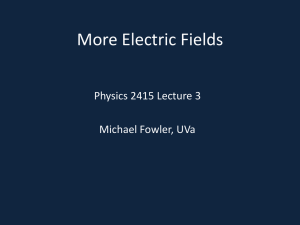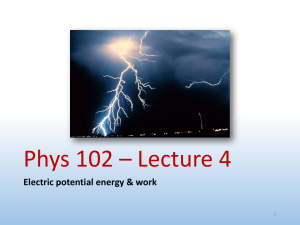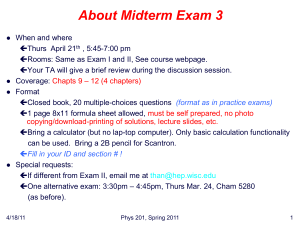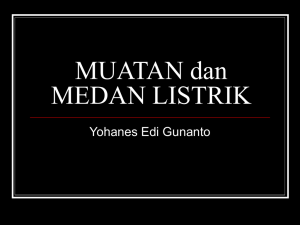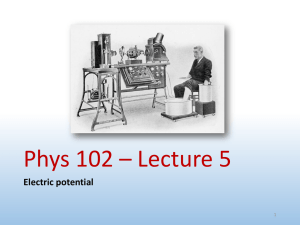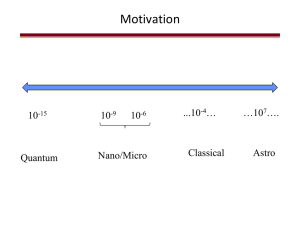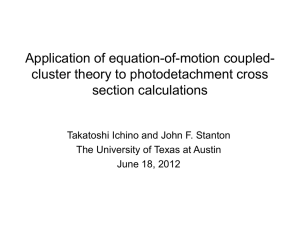Document
advertisement
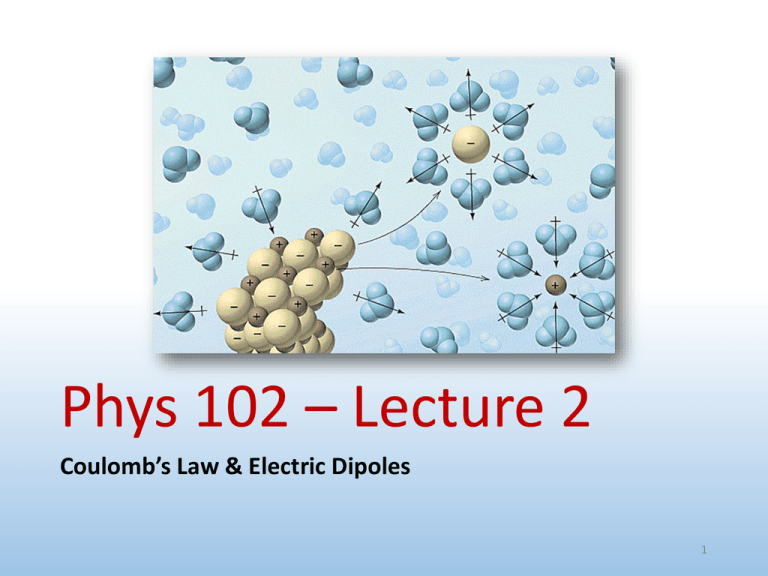
Phys 102 – Lecture 2 Coulomb’s Law & Electric Dipoles 1 Today we will... • Get practice using Coulomb’s law & vector addition • Learn about electric dipoles • Apply these concepts! Molecular interactions Polar vs. nonpolar molecules Hydrophilic vs. hydrophobic Permanent vs. induced dipole Chemistry! Phys. 102, Lecture 2, Slide 2 Recall: Coulomb’s Law Force between charges q1 and q2 separated a distance r: F12 F21 “Force on q1 due to q2” “Coulomb constant” k q1 q 2 r k 9 10 N m 9 2 1 4 πε 0 2 C 2 q1 q 2 “Permittivity of free space” r 2 ε 0 8 .8 5 1 0 12 C 2 Nm Opposite charges attract, like charges repel F1 2 F 2 1 Phys. 102, Lecture 2, Slide 3 2 Superposition principle Total force on charge due to other charges = sum of individual forces Ftot F Ex: what is the force on q1 due to q2, q3, and q4? F1 3 q1 F1 2 q2 F1 2 F1,tot F1 4 F1,tot F1 4 q4 q3 F1,tot F12 F13 F14 F1 3 Order does not matter! Phys. 102, Lecture 2, Slide 4 Calculation: four charges Calculate the total force on charge q1 = +2 μC due to charges q2 = +7 μC, q3 = –3.5 μC Fundamental concept: Superposition F1to t F1 2 F1 3 q1 Approach: • Draw forces • Calculate magnitudes of forces • Add vectors Decompose into x-, y-components Add like components 4m q2 3m 3m q3 May need geometry, trigonometry Phys. 102, Lecture 2, Slide 5 ACT: four charges Which vector best represents the total force on charge q1 = +2 μC due to charges q2 = +7 μC and q3 = –3.5 μC? A. q1 B. C. D. q2 q3 E. Phys. 102, Lecture 2, Slide 6 Calculation: four charges Calculate the total force on charge q1 = +2 μC due to charges q2 = +7 μC and q3 = –3.5 μC • Calculate magnitudes of forces q1 4m q2 3m 3m q3 Phys. 102, Lecture 2, Slide 7 ACT: components What is the x-component of A. 3/4 F12 F12 , F12,x? B. 3/5 F12 C. –4/5 F12 y x • Decompose vectors into components q1 4m q2 3m 3m q3 Phys. 102, Lecture 2, Slide 8 ACT: components What is the y-component of A. 3/4 F13 F13 , F13,y? B. 3/5 F13 C. –4/5 F13 y x • Decompose vectors into components q1 4m q2 3m 3m q3 Phys. 102, Lecture 2, Slide 9 Calculation: four charges Calculate the total force on charge q1 = +2 μC due to charges q2 = +7 μC and q3 = –3.5 μC • Add like components q1 4m q2 3m 3m q4 Phys. 102, Lecture 2, Slide 10 Calculation: four charges Calculate the total force on charge q1 = +2 μC due to charges q2 = +7 μC and q3 = –3.5 μC • Magnitude of total force q1 • Direction of total force 4m q2 3m 3m q3 Phys. 102, Lecture 2, Slide 11 ACT: CheckPoint 1.1 Consider three charges on a circular ring, q1 = +2q, q2 = q3 = +q. A charge +Q is placed at the center of the circle. 1 y 2q What is the x-component of the total force on Q? x A. Fx > 0 B. Fx = 0 C. Fx < 0 Q 2 q 3 q Phys. 102, Lecture 2, Slide 12 ACT: CheckPoint 1.2 Consider three charges on a circular ring, q1 = +2q, q2 = q3 = +q. A charge +Q is placed at the center of the circle. 1 y 2q What is the y-component of the total force on Q? x A. Fy > 0 B. Fy = 0 C. Fy < 0 Q 2 q 3 q Phys. 102, Lecture 2, Slide 13 Electric dipole & dipole moment A positive and negative charge of equal magnitude q separated by a (usually small) distance d +q d –q = +q –q = p Dipole moment is measure of separated + and – charges p qd From – to + charge (by convention) Note: opposite from Lewis notation (Chemistry) definition What are examples of electric dipoles? Phys. 102, Lecture 2, Slide 14 Molecular dipole Electrons are not shared equally between chemically bonded atoms Charge imbalance creates a bond dipole Ex: HF (hydrofluoric acid) Ex: H20 (water) Slightly negative Slightly positive 2δ- δ+ δp δ+ δ+ Polar ptot > 0 p Ex: CO2 (carbon dioxide) 2δ+ δ- δ- p0 Nonpolar ptot = 0 Phys. 102, Lecture 2, Slide 15 ACT: CheckPoint 2.1 An electric dipole is placed near a large positive charge +Q. In what direction is the net force on the dipole? A. Left +Q B. Zero C. Right –q +q Phys. 102, Lecture 2, Slide 16 ACT: Dipole & 2 charges Consider an electric dipole placed an equal distance from a +Q and a –Q charge. Does the dipole move? +q +Q –Q –q A. Yes B. No Phys. 102, Lecture 2, Slide 17 Ion-dipole interactions Polar molecules are attracted to ions Dipole moment aligns away from + charge, toward – charge Ex: ions in water & solubility “Hydration shell” Ionic compounds (ex: salts) dissolve in water Phys. 102, Lecture 2, Slide 18 ACT: Two dipoles Which of the following arrangement of two dipoles leads to a net attractive force between the two? –q +q A. –q +q –q +q –q +q B. –q +q +q –q C. D. Dipoles are neutral, they cannot attract or repel Phys. 102, Lecture 2, Slide 19 Dipole-dipole interactions Polar molecules interact together Dipole moments align end-to-end + to – Like magnets! Ex: hydrogen bond is a dipole-dipole interaction between water molecules Hydrogen bond Structure of ice Snowflake Phys. 102, Lecture 2, Slide 20 Hydrophilic vs. hydrophobic Polar molecules interact with charged & polar molecules Ex: charged & polar molecules attract water, nonpolar molecules do not Hydrophilic Hydrophobic “attract water” “repel water” Hydrophilic Nonpolar inside Nonpolar Polar outside Polar “coiled coil” Hydrophobic Oil and water Cell membranes Protein structure Phys. 102, Lecture 2, Slide 21 ACT: Charge & conductor An uncharged conducting sphere is placed next to a fixed + charge. What happens when the uncharged sphere is released? + A. Nothing B. Attracted to + sphere C. Repelled from + sphere Phys. 102, Lecture 2, Slide 22 Molecular interactions Interactions between molecules are understood in terms of charges and electric dipoles interacting by Coulomb’s law Ion-dipole Dipole-dipole Dipole-induced dipole Induced dipoleinduced dipole? Ion-induced dipole Yes! Two nonpolar molecules can induce dipoles in each other and interact! London dispersion or van der Waals force Phys. 102, Lecture 2, Slide 23 Summary of today’s lecture • Coulomb’s law • Superposition principle Ftot F • Electric dipole & dipole moment Permanent vs. induced dipole Phys. 102, Lecture 2, Slide 24

